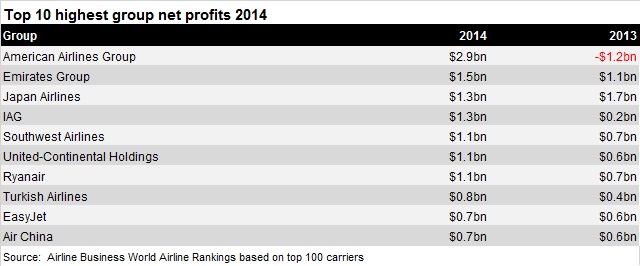For an industry so used to shocks and red ink over the last 15 years, it is perhaps unsurprising that airlines may take some convincing that they've never had it so good.
This year's Airline Business World Airline Rankings show that net profits among the leading 100 carriers reached nearly $12 billion in 2014 – and over $30 billion at an operating level. It marks the fifth consecutive collective net profit among leading carriers and the sixth year of operating profits. And with oil prices back at more palatable levels, this is set to continue again, with IATA projecting record industry profits in 2015.

Yet the mixed nature of the business means that while many are thriving, others remain under pressure. For some, still gripped with restructuring, there is the possibility the peak of the economic cycle may come and go without them profiting from the good times.
While fortunes within regions – and in some cases, sectors – differ widely, there is no doubt that North American carriers are leading the industry's new-found profitability.

The region's operators again prospered in 2014, as the World Airline Rankings show collective net profit for the leading American carriers of nearly $8 billion. Though this is below the $12 billion generated in 2013, that figure was distorted by Delta Air Lines' $8 billion one-off income tax gain.
Collective operating profits showed the gains more clearly, increasing $3.5 billion to top $17 billion in 2014. That contributed over half the profits of the top 100 carriers. While Europe was the second-most profitable region, generating collective operating profits of nearly $6 billion in 2014, Asia-Pacific carriers are roughly on a par when when a heavy non-cash writedown at Qantas is excluded.
American Airlines, after its successful merger with US Airways, generated the highest net profit last year, with almost $3 billion. This marked a sharp turnaround on losses last year relating to one-off restructuring costs. American's group net profit was almost double the amount of the next highest, Emirates.

American also led the way in 2014 in operating profits. The carrier, together with fellow US operators United-Continental, Southwest Airlines and Delta Air Lines, generated collective operating profits of around $11 billion in 2014.

One of the keys to the improved profit performance was the sharp drop in oil prices in the second half of 2014, which was as unexpected as it was welcome for airlines. Even with the barrel price of crude oil having picked up a little since dipping below the $50 mark early this year, to around $60 a barrel, prices remain significantly below 2014 levels.
But while lower fuel prices equal reduced costs for airlines, they do not automatically translate to that.
This is partly because most airlines have to some extent been tied to hedging strategies which took the edge off fuel pain when oil prices were at their highest. Depending on how much unwinding it could take, and when it will occur, airlines will initially have to take some one-off charges to settle these.
Delta, for example, took a $372 million charge in mark-to-market fuel hedge losses in the first quarter, but was still able to double its profits in the quarter, aided by lower fuel prices.
Further complicating the potential fuel gains is the rapid strengthening of the US dollar against many currencies. This has had a big impact on costs paid for in US dollars for those airlines in non US-dollar-denominated carriers – and has further contributed to the split in fortunes between the highly profitable North American operators and those in other regions. This mitigates the gains from lower fuel costs.
This also has an impact on the World Airline Rankings, which lists airline financials in US dollars for comparison purposes, as the change versus 2013 is impacted by the stronger US dollar. As a result, for most airlines not reporting in US dollars, the comparison versus 2013 in US dollars is less favourable than when reported in local currency, especially for those with a financial year that ended in March 2015.
Source: Airline Business























